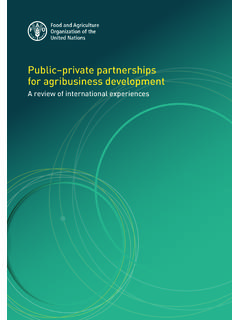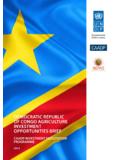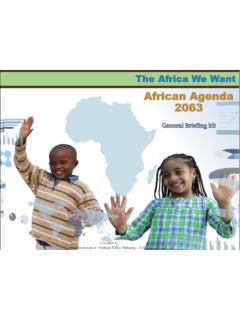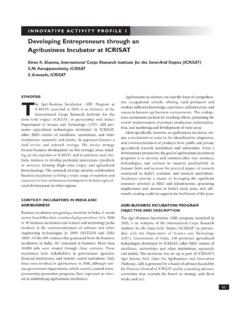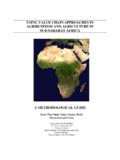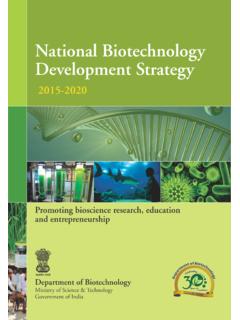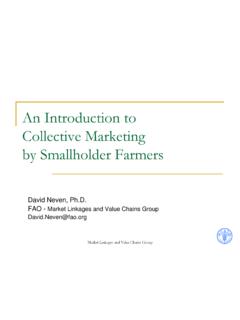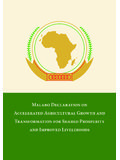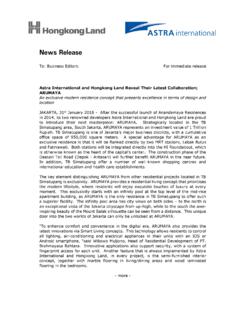Transcription of Growing Africa - World Bank
1 Growing Africa Unlocking the Potential of Agribusiness i Growing Africa Unlocking the Potential of Agribusiness January 2013. AFTFP/AFTAI. Photos on the front cover and pages xiii, 1, 13, 23, 107, courtesy of the World Bank Photo Library;. photos on pages 7 and 33 courtesy of William Crosse. iii Contents Foreword.. vii Acknowledgements .. ix Acronyms and Abbreviations .. x Executive Summary .. xiii Introduction.. 1. Why a report on agribusiness? .. 2. Analytical framework and data sources for this report .. 3. Overview of the report .. 5. Agribusiness in Africa A large sector .. 7. The size of the agricultural and agribusiness sector .. 8. Structure of agribusiness.. 9. Bright prospects for agribusiness .. 13. Strong market demand.
2 14. Positive factors on the supply side, too .. 16. A better policy environment and strong private sector interest .. 18. Potentially large development impacts from inclusive growth .. 19. Overall performance has lagged .. 23. Growth.. 24. Trade .. 24. Productivity .. 28. Constraints to agribusiness identi ed through speci c value chains .. 33. Rice: Lack of seed, irrigation, and mechanization .. 34. Maize in Zambia: Distortionary policy interventions.. 42. Cocoa in Ghana: The need for better-organized and more skilled smallholders .. 46. Dairy in Kenya: Upgrading informal value chains .. 50. Green beans in Kenya: Meeting ever more stringent export standards .. 52. Summary of value chain constraints .. 56. Overcoming constraints: An agenda for getting agribusiness moving.
3 59. Improving market performance and meeting new demands.. 60. Facilitating access to inputs and technology .. 72. Enhancing access to land and tenure security for both smallholders and investors.. 82. Financing agribusiness .. 87. Upgrading infrastructure, using public-private partnerships where possible .. 94. Building skills and entrepreneurship.. 98. Making agribusiness inclusive .. 100. iv Growing Africa : Unlocking the Potential of Agribusiness Getting the job done: Implementing the agenda.. 107. Putting agriculture and agribusiness at the top of the agenda.. 108. Taking a proactive stance: Lessons from success in other regions .. 108. Learning from failures in Africa .. 112. Getting started by focusing on a few carefully selected priorities.
4 113. Engaging strategic good practice investors .. 115. Strengthening safeguards: Screening investments for sustainable growth.. 115. Getting the Job done through an agribusiness transformation team .. 118. References.. 121. List of Tables Table A: Summary of major constraints by value chain.. xxi Table : Importance of selected determinants of competitiveness in four types of value chains.. 10. Table : Current yield relative to estimated potential yield .. 17. Table : Decomposition of agricultural growth in Sub-Saharan Africa (not including South Africa ) .. 31. Table : Overview of production, consumption, and trade of case study commodities.. 35. Table : Rice in Ghana and Senegal .. 37. Table : Examples of existing standards for green bean producers in Kenya.
5 54. Table : Costs and returns to green bean farmers in Kenya, 2006 .. 55. Table : Summary of major constraints identi ed by snapshot reviews of value chains .. 57. Table : Recent policy interventions in grain markets in Eastern and Southern Africa .. 62. Table : Summary of major ICT services to agriculture and agribusiness, Kenya .. 65. Table : Number of new varieties and hybrids registered with national seed authorities (2005 08) .. 75. Table : Comparison of research systems in Sub-Saharan Africa , India, and the United States around 2000 .. 81. Table : Indicators of sector growth, case studies of competitiveness.. 111. List of Figures Figure A: Dual but interlinked value chains for livestock .. xv Figure B: Projected value of the food markets in Sub-Saharan Africa .
6 Xvi Figure C: Exploitable yield gaps are high for maize in Africa .. xvi Figure D: Shares of World agricultural exports (1960 2008) .. xvii Figure E: Ratio of cash crop yields in Africa compared to Asia and Latin America .. xvii Figure F: Comparison of fertilizer value chain costs, Africa and Thailand (2006) .. xxiv Figure G: Adoption of Bt cotton in Burkina Faso through a partnership with Monsanto . xxiv Figure : The ratio of food processing to agricultural value added rises with incomes .. 9. Figure : Agro-industry as share of total manufacturing value added, mid-2000s.. 9. v Figure : Share of total output value, West and Central Africa .. 9. Figure : Dual but interlinked value chains for livestock .. 11. Figure : Percent change in real commodity prices of key African agricultural exports, imports, and inputs, 2000 10.
7 14. Figure : Exploitable yield gaps are high for maize in Africa .. 17. Figure : Trends in agricultural GDP and per capita agricultural GDP in Sub-Saharan Africa .. 24. Figure : Value of agricultural exports and imports, Sub-Saharan Africa (1970 2009).. 25. Figure : Net agricultural exports as a share of agricultural GDP.. 25. Figure : Shares of World agricultural exports (1960 2009) .. 26. Figure : Global share of agricultural exports by country (1991 93 and 2007 09) .. 26. Figure : Composition of Sub-Saharan Africa s exports by commodity, share of total value (2007 09) .. 27. Figure : Sub-Saharan Africa 's share of World exports by commodity (raw and processed). (1991 93 and 2006 08).. 27. Figure : Africa 's shares of global imports for top 11 imports (raw and processed).
8 (1991 93 and 2006 08) .. 28. Figure : Composition of Africa 's imports by commodity group (total: US$ 24 billion). (2006 08) .. 28. Figure : Index of food crop yields in Africa relative to the rest of the developing World (=100) (2008 10) .. 29. Figure : Ratio of cash crop yields in Africa vs. Asia and Latin America .. 29. Figure : Sub-Saharan Africa maize yields relative to non-African countries with rainfed maize production (1961 2010) .. 30. Figure : Change in livestock productivity, meat (1980 2005) .. 30. Figure : Change in livestock productivity, milk (1980 2005) .. 30. Figure : TFP growth in Africa lags other regions.. 30. Figure : Rice production and imports, Sub-Saharan Africa .. 36. Figure : Production costs for rice in Ghana and Senegal benchmarked to Thailand.
9 39. Figure : Value build-up in the rice markets of Senegal and Ghana.. 40. Figure : Change in adoption rates of improved maize varieties, 1997 2007 .. 45. Figure : Per capita consumption of cocoa, selected countries (kg per person) .. 47. Figure : Escalating import tari s for di erent cocoa products .. 49. Figure : Kenya's milk marketing channels, 2002 (million liters) .. 51. Figure : Export value chain for green beans .. 56. Figure : Nominal rate of assistance for exportables and importables, Africa (2000 04) .. 61. Figure : Average tari s on major food imports for the 20 largest countries (late 2000s) .. 61. Figure : Price trends for retail maize in Nairobi, Kenya .. 63. Figure : Spectrum of regulatory and market requirements in agri-food systems.
10 69. Figure : Fertilizer use lags badly in Africa .. 72. vi Growing Africa : Unlocking the Potential of Agribusiness Figure : Major bottlenecks along the seed value chain .. 74. Figure : Comparison of fertilizer value chain costs, Africa and Thailand (2006) .. 77. Figure : Nitrogen-based fertilizer prices in 2010 (US$ per ton of nitrogen) .. 78. Figure : Share of commercial banks' lending to agriculture relative to share of agricultural GDP .. 88. Figure : Agribusiness training is needed at many levels .. 99. List of Boxes Box : Working de nitions for this report .. 3. Box : Globally agribusiness is big business .. 8. Box : Explosion of urban food markets.. 15. Box : Thai agribusiness as a model for Africa .. 20. Box : Communities contribute to innovative rice production in Ghana.










